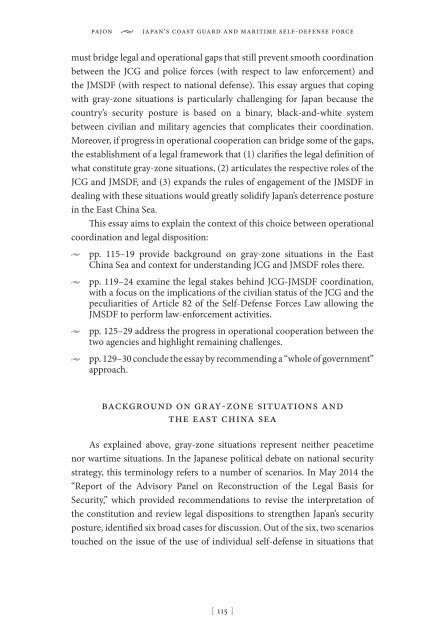2jBVKVf
2jBVKVf
2jBVKVf
Create successful ePaper yourself
Turn your PDF publications into a flip-book with our unique Google optimized e-Paper software.
pajon • japan’s coast guard and maritime self-defense force<br />
must bridge legal and operational gaps that still prevent smooth coordination<br />
between the JCG and police forces (with respect to law enforcement) and<br />
the JMSDF (with respect to national defense). This essay argues that coping<br />
with gray-zone situations is particularly challenging for Japan because the<br />
country’s security posture is based on a binary, black-and-white system<br />
between civilian and military agencies that complicates their coordination.<br />
Moreover, if progress in operational cooperation can bridge some of the gaps,<br />
the establishment of a legal framework that (1) clarifies the legal definition of<br />
what constitute gray-zone situations, (2) articulates the respective roles of the<br />
JCG and JMSDF, and (3) expands the rules of engagement of the JMSDF in<br />
dealing with these situations would greatly solidify Japan’s deterrence posture<br />
in the East China Sea.<br />
This essay aims to explain the context of this choice between operational<br />
coordination and legal disposition:<br />
u pp. 115–19 provide background on gray-zone situations in the East<br />
China Sea and context for understanding JCG and JMSDF roles there.<br />
u<br />
u<br />
u<br />
pp. 119–24 examine the legal stakes behind JCG-JMSDF coordination,<br />
with a focus on the implications of the civilian status of the JCG and the<br />
peculiarities of Article 82 of the Self-Defense Forces Law allowing the<br />
JMSDF to perform law-enforcement activities.<br />
pp. 125–29 address the progress in operational cooperation between the<br />
two agencies and highlight remaining challenges.<br />
pp. 129–30 conclude the essay by recommending a “whole of government”<br />
approach.<br />
background on gray-zone situations and<br />
the east china sea<br />
As explained above, gray-zone situations represent neither peacetime<br />
nor wartime situations. In the Japanese political debate on national security<br />
strategy, this terminology refers to a number of scenarios. In May 2014 the<br />
“Report of the Advisory Panel on Reconstruction of the Legal Basis for<br />
Security,” which provided recommendations to revise the interpretation of<br />
the constitution and review legal dispositions to strengthen Japan’s security<br />
posture, identified six broad cases for discussion. Out of the six, two scenarios<br />
touched on the issue of the use of individual self-defense in situations that<br />
[ 115 ]


